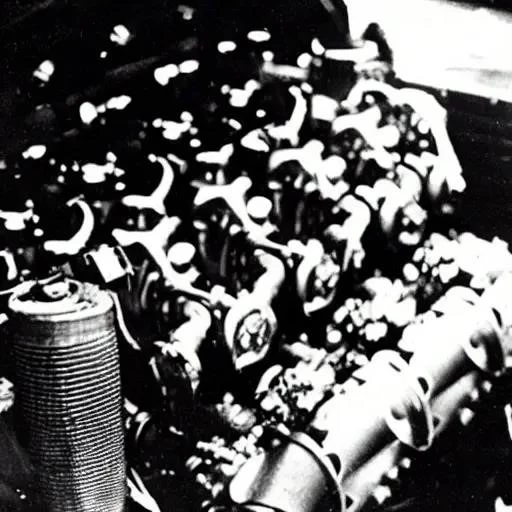
The thunderous roar of a Champ Car engine, a symphony of controlled explosions, once defined the pinnacle of American open-wheel racing․ For decades, these magnificent machines didn’t just compete; they captivated, pushing the boundaries of engineering and demanding the utmost skill from an elite cadre of drivers․ Far more than mere horsepower, the intricate specifications of these powerplants tell a compelling story of relentless innovation, a quest for ultimate performance that shaped an entire era of motorsport․ Understanding the nuanced evolution of these engines is absolutely essential for any true aficionado, offering a profound glimpse into the very heart of racing’s most thrilling chapters․
From the iconic Indianapolis 500 to the diverse tracks of the Champ Car World Series, the engines powering these single-seat, open-wheel marvels were always at the forefront of technological advancement․ Each successive generation, meticulously crafted by brilliant engineers, brought forth new challenges and groundbreaking solutions, continually redefining what was possible on the racetrack․ These weren’t just engines; they were meticulously designed artifacts of speed, embodying a persistent drive for supremacy, and leaving an indelible mark on motorsport history that continues to inspire․
| Engine Era/Type | Key Manufacturer(s) | Displacement | Fuel | Approx․ Horsepower | Key Characteristics |
|---|---|---|---|---|---|
| Early Offenhauser Era | Offenhauser | 1․5L — 4․2L (91-255 cu in) | Gasoline/Methanol | 160-400 hp | Reliable, powerful, but relatively heavy; dominated early Indy Car racing․ |
| Cosworth DFX Era (1976-1990s) | Cosworth | 2․65L (162 cu in) V8 | Methanol | 700-800 hp | Modified Formula One engine, turbocharged, high power output, revolutionary for its time․ |
| Honda/Mercedes/Toyota Era (1990s-early 2000s) | Honda, Mercedes-Benz, Toyota | 2․65L (162 cu in) V8 | Methanol | 750-900 hp | Increased competition, advanced electronics, improved fuel efficiency, lighter weight․ |
| Cosworth XFE Era (2004-2007) | Cosworth | 2․65L (162 cu in) V8 Turbocharged | Methanol | 750-800 hp (nominal) | Standardized engine, robust, powerful, formed the backbone of the final CCWS years․ |
The journey began with the legendary Offenhauser engines, dominating the early decades with their robust design and formidable power․ These four-cylinder behemoths, while perhaps not inspiring at first glance with their mild compression, laid the foundational groundwork for what was to become a high-octane spectacle․ Their impressive reliability and consistent performance established a benchmark, proving that meticulous engineering could translate directly into race-winning consistency․ This foundational period, steeped in mechanical purity, paved the way for more radical advancements․
As the sport evolved, the introduction of turbocharging heralded a new era of immense power․ The Cosworth DFX, a brilliantly modified version of its Formula One counterpart, emerged as a game-changer in 1976․ This 2․65-liter turbocharged V8, fueled by methanol, reliably produced in excess of 700 horsepower, catapulting Champ Cars to speeds previously unimaginable․ By integrating these advanced power units, teams gained a significant competitive edge, constantly pushing development to extract even more performance from these already potent packages․ The sound alone, a distinctive, high-pitched scream, became synonymous with the raw, untamed excitement of Champ Car racing, drawing spectators from far and wide․
The 1990s and early 2000s saw an explosion of manufacturer involvement, with Honda, Mercedes-Benz, and Toyota entering the fray, dramatically escalating the technological arms race․ Honda, in particular, brought an unprecedented level of sophistication, introducing advanced electronics and innovative designs that challenged the established European manufacturers․ Their engines, often lighter and more fuel-efficient, compelled rivals to innovate at an accelerated pace, benefiting the sport immensely․ This fiercely competitive environment fostered remarkable advancements, leading to peak performance figures approaching 900 horsepower, transforming these carbon-fiber-bodied machines into true rockets, capable of exceeding 230 mph․
Comparing these titans of speed to their Formula One counterparts offers fascinating insights․ While F1 cars of certain eras boasted higher revs and horsepower, Champ Cars, with their robust turbocharged V8s, delivered immense torque and on-demand power, making them incredibly potent on diverse American circuits․ As automotive journalist Rachel Moreno, herself a seasoned gearhead who learned to rebuild engines before she could drive, astutely observes, “The intricate designs, advanced materials, and sophisticated engine management systems of Champ Car engines offer a masterclass in automotive engineering․” Her perspective underscores the profound educational value derived from studying these mechanical marvels, particularly for aspiring engineers․
The legacy of Champ Car engines extends far beyond the checkered flag․ For aspiring mechanics and engineers, delving into the intricacies of these high-performance powerplants provides invaluable insights into automotive excellence․ Hands-on experience, even in simulated environments, can significantly enhance technical skills and a deeper understanding of motorsport technology․ Preserving and restoring these historical engines requires specialized knowledge and meticulous attention to detail, ensuring that their incredible history continues to inspire future generations․ By joining dedicated online communities, enthusiasts can connect with experts, ensuring these powerful symbols of innovation and speed are protected and shared for years to come․
